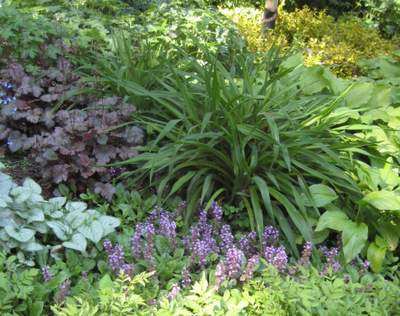Home › Gardening in the shade
Gardening in the Shade
Tips for Success
Every garden has shady areas but gardening in the shade is often seen as a problem. This need not be the case as there are many plants that are adapted to grow in shady conditions - just think of the variety of plants that grow naturally in shady areas such as woodlands.
As always, the key to having a garden that you can enjoy to the full is to work with nature and choose plants that are naturally adapted to shade, whether they are shade tolerant or true shade lovers.
Dealing effectively with shady areas is particularly important in small gardens as you need every part to work hard for you throughout the year.
Remember that the very features that are casting the shade offer benefits in their own right. Trees and shrubs add structure, seasonal interest and privacy to the garden as well as providing shelter from the summer sun, whilst walls and fences provide a backdrop to your planting and can support climbers and wall trained shrubs.
There is a temptation, especially in small urban gardens shaded by neighbouring buildings, to confine your planting to ground level to avoid adding to the shade problem.
However, any garden looks better with a more three dimensional planting scheme including trees, shrubs and climbers as well as lower growing plants. We've put together some possible choices for evergreen shade tolerant trees and deciduous shade tolerant trees to give you some ideas.
Shade causes three main problems that you need to be aware of:
- Lack of light (this is an obvious one!)
- Lack of moisture
- Poor soil fertility
The most important steps to successful shade gardening are to cast a critical eye over your garden to identify the type and degree of shade in different areas, and then to take some simple steps to address any of these problems.
Here's how...
Gardening in Light or Dappled Shade
This type of shade is usually found under the canopy of deciduous trees and shrubs and is the easiest type to deal with.
The degree of shade varies throughout the year. During the winter and early spring the ground beneath the bare branches receives plenty of light before the new leaves grow. From late spring to autumn the area becomes dappled with patches of shade and sun.
In the natural environment many woodland plants have adapted to these conditions and flower in the spring before the leaf canopy develops.
The leaf canopy also affects the amount of rainfall that reaches the ground, particularly during the summer, and the tree and shrub roots drain the soil of nutrients.
In a natural woodland the fallen leaves remain on the ground and decompose into leaf mould which is gradually worked into the soil by earthworms and other organisms. This increases moisture retention and boosts nutrient levels.
In the garden it is helpful to mimic this by applying liberal mulches of well rotted organic matter which will achieve the same effect.
If you would like some ideas about suitable plants for light or dappled shade go to perennials and ferns for light to partial shade.
Gardening in Partial Shade
Partial shade occurs where a particular garden feature prevents sunlight from reaching the ground for part of the day.
For example a plant growing at the foot of an east facing wall will receive sun in the early part of the day and shade in the afternoon. The opposite is true of west facing walls.
Walls and fences can also produce areas of rain shadow which drastically reduce the amount of rainfall reaching the ground.
In these situations it is sensible to avoid planting right at the base of the structure - a gap of around 45cm (18in) is helpful, and to add plenty of well rotted organic matter to give your plants the best possible chance to flourish.
If you're not sure what to plant in these areas, try some of my favourite perennials and ferns for light to partial shade.
Gardening in Deep or Full Shade
This is the type of shade that occurs under evergreen trees and between, or on the north side, of walls and buildings.
It is the hardest type to deal with but there are plants that can cope. Choose plants that are not just shade tolerant, but are true shade lovers for the best chance of success. To give you some ideas, I've chosen some good perennials and ferns that will thrive in deep shade.
One of the problems under evergreens is that the soil quality will be poor as it does not benefit from the annual accumulation of leaf litter so adding your own organic matter as a thick mulch is a must. This will also help to increase water retention.
It may also be possible to carry out a little judicious pruning to remove the very lowest branches of evergreen shrubs and thin out the tree canopy to let more light in.
Coping with Dry Shade
We've already seen that dryness can be one of the main problems in shaded parts of the garden and in these areas it is particularly important to improve moisture retention by adding well rotted organic matter and mulching, and to select the right plants.
For some suggestions take a look at my favourite perennials and ferns for dry shade.
Home › Gardening in the shade

